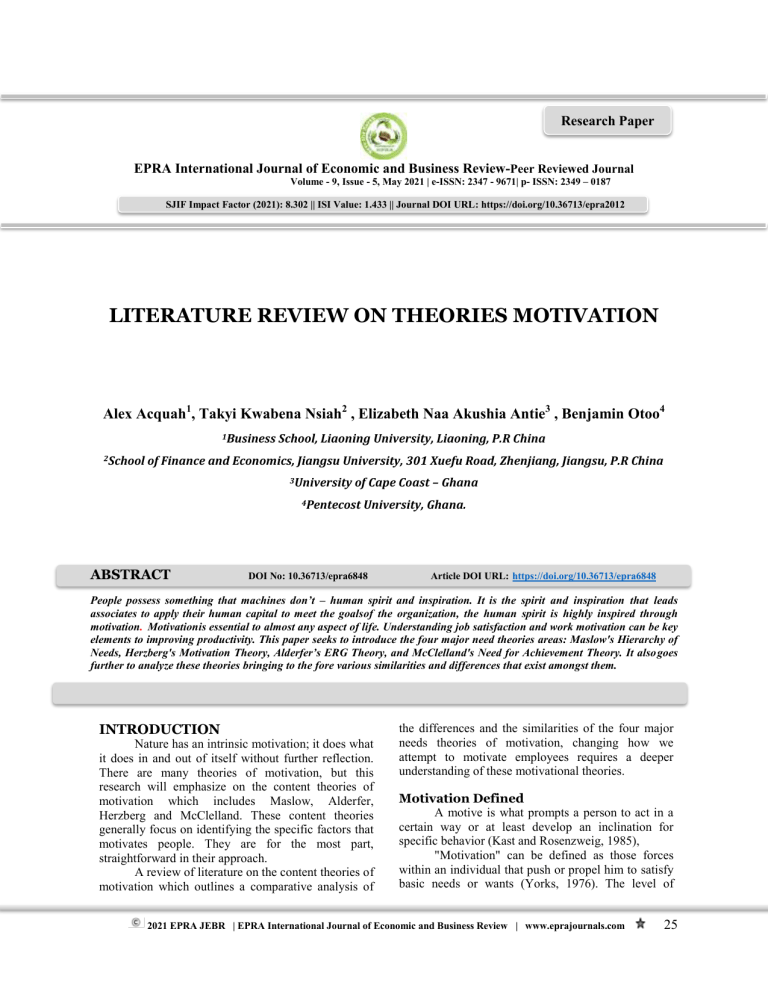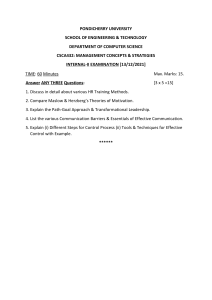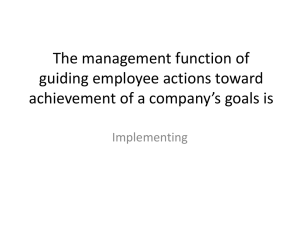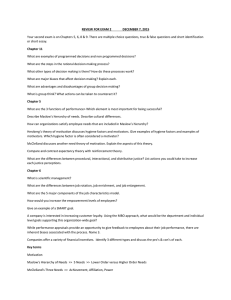
Research Paper EPRA International Journal of Economic and Business Review-Peer Reviewed Journal Volume - 9, Issue - 5, May 2021 | e-ISSN: 2347 - 9671| p- ISSN: 2349 – 0187 SJIF Impact Factor (2021): 8.302 || ISI Value: 1.433 || Journal DOI URL: https://doi.org/10.36713/epra2012 LITERATURE REVIEW ON THEORIES MOTIVATION Alex Acquah1, Takyi Kwabena Nsiah2 , Elizabeth Naa Akushia Antie3 , Benjamin Otoo4 1Business 2School School, Liaoning University, Liaoning, P.R China of Finance and Economics, Jiangsu University, 301 Xuefu Road, Zhenjiang, Jiangsu, P.R China 3University of Cape Coast – Ghana 4Pentecost ABSTRACT University, Ghana. DOI No: 10.36713/epra6848 Article DOI URL: https://doi.org/10.36713/epra6848 People possess something that machines don’t – human spirit and inspiration. It is the spirit and inspiration that leads associates to apply their human capital to meet the goalsof the organization, the human spirit is highly inspired through motivation. Motivationis essential to almost any aspect of life. Understanding job satisfaction and work motivation can be key elements to improving productivity. This paper seeks to introduce the four major need theories areas: Maslow's Hierarchy of Needs, Herzberg's Motivation Theory, Alderfer’s ERG Theory, and McClelland's Need for Achievement Theory. It also goes further to analyze these theories bringing to the fore various similarities and differences that exist amongst them. INTRODUCTION Nature has an intrinsic motivation; it does what it does in and out of itself without further reflection. There are many theories of motivation, but this research will emphasize on the content theories of motivation which includes Maslow, Alderfer, Herzberg and McClelland. These content theories generally focus on identifying the specific factors that motivates people. They are for the most part, straightforward in their approach. A review of literature on the content theories of motivation which outlines a comparative analysis of the differences and the similarities of the four major needs theories of motivation, changing how we attempt to motivate employees requires a deeper understanding of these motivational theories. Motivation Defined A motive is what prompts a person to act in a certain way or at least develop an inclination for specific behavior (Kast and Rosenzweig, 1985), "Motivation" can be defined as those forces within an individual that push or propel him to satisfy basic needs or wants (Yorks, 1976). The level of 2021 EPRA JEBR | EPRA International Journal of Economic and Business Review | www.eprajournals.com 25 SJIF Impact Factor (2021):8.302 || DOI: 10.36713/epra2012 | Volume–9 | Issue-5 | May 2021 | e- ISSN: 2347-9671 | p- ISSN: 2349-0187 needs will determine what rewards will satisfy an employee. According to Dessler, most psychologists believe that all motivation is ultimately derived from a tension that results when one or more of our important needs are unsatisfied (Dessler, 1986). OVERVIEW OF THEORIES Maslow's Hierarchy of Needs This is the earliest and most widely known theory of motivation, developed by Abraham Maslow (1943) in the 1940s and 1950s. Abraham Maslow believed that man is inherently good and argued that individuals possess a constantly growing inner drive that has great potential. The needs hierarchy system, devised by Maslow (1954), is a commonly used scheme for classifying human motives. It involves five categories of motives arranged with lower-level needs on the bottom which must be satisfied first, before the higher-level needs come into play (Wallace, Goldstein and Nathan, 1987). The five general levels of needs as described by Stephen P. Robbins and Timothy A. Judge are shown in the following hierarchical order. 1.) Physiological. Includes hunger, thirst, shelter, sex, and other bodily needs 2.) Safety, Security and protection from physical and emotional harm. 3.) Social, Affection, belongingness, acceptance and friendship 4.) Esteem, Internal factors such as self-respect, autonomy, and achievement, and external factors such as status, recognition, and attention. 5.) Self-actualization, Drive to become what one is capable of becoming; includes growth, achieving one’s potential, and self-fulfillment. A person's level of aspiration is closely related to the hierarchy of needs and attitudes will determine the individual route which the person takes for the satisfaction of his needs (Haimann, 1973). The ultimate need category described by Maslow was that of self- actualization. Alderfer – ERG theory Alderfer (Furnham, 2008) distinguished three classes of needs: existence, relatedness and growth. This theory is very flexible since it explains needs as a range rather than as a hierarchy. These classes of needs have been explained below. Existence needs: These include needs for basic material necessities. In short, it includes an individual’s physiological and physical safety needs. Relatedness needs: Individuals need significant relationships (be with family, peers or superiors), love and belongingness, they strive toward reaching public fame and recognition. This class of needs contain Maslow’s social needs and external component of esteem needs. Growth needs: Need for self-development, personal growth and advancement form this class of need. This class of needs contain Maslow’s selfactualization needs and intrinsic component of esteem needs. Herzberg's Motivation Hygiene Theory Herzberg's motivation hygiene theory is often called the two-factor theory and focuses on those sources of motivation which are pertinent to the accomplishment of work (Hall and Williams, 1986). This theory says that there are some factors known as motivating factors that cause job satisfaction, and some other separated factors called hygiene factors which cause dissatisfaction. He stated further that the opposite of satisfaction is not dissatisfaction, but rather, no satisfaction. According to Herzberg (1987) the job satisfiers deal with the factors involved in doing the job, whereas the job dissatisfiers deal with the factors which define the job context. He categorized motivating factors (satisfiers) as achievement, recognition, work itself, advancement and growth whereas hygiene factors (dissatisfiers) also include company policy, supervision, working conditions, status and salary. (Herzberg, Mousner, and Snyderman, 1959). According to Herzberg, hygiene cannot motivate, and when used to achieve this goal it can actually produce negative effects over the long run. The motivators are more complex and subjective, and often too elusive to measure. But to the extent that management concentrates on hygiene, while at the same time neglecting motivators, workers are probably going to seek more of the hygiene (Hamner and Organ, 1978). This has a negative effect on developing a motivated workforce. McClelland – Need for achievement, affiliation and power In the early 1960s McClelland – built on Maslow’s work – described three human motivators. McClelland (Arnold et al., 2005) He also used need classifications and focuses on the need for achievement, affiliation, and power. McClelland’s theory differs from Maslow’s and Alderfer’s, which focus on satisfying existing needs rather than creating or developing needs. This dominant motivator depends on our culture and life experiences. The three motivators are achievement, affiliation power. 2021 EPRA JEBR | EPRA International Journal of Economic and Business Review | www.eprajournals.com 26 SJIF Impact Factor (2021):8.302 || DOI: 10.36713/epra2012 | Volume–9 | Issue-5 | May 2021 | e- ISSN: 2347-9671 | p- ISSN: 2349-0187 Achievement - the need for achievement involves the desire to independently master objects, ideas and other people, and to increase one's selfesteem through the exercise of one's talent (Wallace, Goldstein and Nathan, 1987). Affiliation motivation – a need for love, belonging and relatedness, that is people have a strong need for friendships and want to belong within a social group, need to be liked and held in popular regard. They are team players, and they may be less effective in leadership positions (Michael A. Hitt, C. Chet Miller 2006). human behavior it follows that people will be highly motivated when they believe that their behavior will lead to certain rewards (Herzberg, 1976). Maslow Alderfer Physiological Existence Authority/power motivation – a need to control over one’s own work or the work of others. These persons are authority motivated. There is a strong need to lead and to succeed in their ideas. It is also needed to increase personal status and prestige. This person would like to control and influence others (Michael A. Hitt, C. Chet Miller 2006). The effective manager must know what motivates someone to perform and how to satisfy the needs of the employee. Since motivation gives direction and intensity to COMPARISON OF THEORIES The content theories proposed by four psychologists have some similarities and differences which have been summarized in the table below McClelland Herzberg Hygiene Safety and security Belongingness and love Relatedness Need for Affiliation Self-esteem Growth Need for power Self-actualization Motivators Need for achievement Source: Gordon R. Judith et al, Management and Organizational Behavior, Allyn and Bacon, 1990 The underlying concept of motivation is some driving force within individuals by which they attempt to achieve some goals in order to satisfy some need or other. On a comparison of these Need Theories in the table above, it is seen that the Existence Needs of Alderfer is roughly equal to Maslow's Physiological and Safety Needs; The Relatedness Need of Alderfer and the Affiliation Need of McClelland is more or less equivalent to the Social Needs of Maslow. The Hygiene factors of Herzberg are nothing but the Physiological, Safety and love. The Esteem and Selfactualization Needs ofMaslow comprises the Growth Needs set by Alderfer, the Need for Achievement, the Need for Power set by McClelland and the Motivators of Herzberg. (Allyn and Bacon, 1990) When Herzberg and Maslow models are compared both emphasize the same set of relationships. Maslow centers on human needs of the psychological person at work or anywhere else. Herzberg focuses on that same person in terms of how job conditions affect his basic needs. Herzberg motivation maintenance model seems to say in general is that managerial and professional workers have reach a stage of socioeconomic progress. (Burke, 1987). The major differences are McClelland's emphasis on socially acquired needs (Gibson, Ivancevich and Donnelly, 1979). Maslow is helpful in identifying needs or motives and Herzberg provides us with insights into the goals and incentives that tend to satisfy the needs (Hersey and Blanchard 1982). Moreover, Herzberg addressed salary not as a motivator in the way that the primary motivators are, like achievement and recognition. Salary can be a motivator, thus increment in salary, but we cannot say that it is an incentive. Maslow said, money or salary is needed to buy food to eat, to provide shelter, etc. It can be a physiological need. 2021 EPRA JEBR | EPRA International Journal of Economic and Business Review | www.eprajournals.com 27 SJIF Impact Factor (2021):8.302 || DOI: 10.36713/epra2012 | Volume–9 | Issue-5 | May 2021 | e- ISSN: 2347-9671 | p- ISSN: 2349-0187 Similarities between Maslow’s theory and the ERG theory Growth Needs Relatedness Needs Existence Needs It is seen in the diagram above that Maslow’s self-actualization needs is similar to Alderfer’s growth needs, belongingness and love is similar to relatedness and safety and security is similar to existence needs. Alderfer agreed with Maslow that unsatisfied needs motivate individuals. Alderfer also agreed that individuals generally move up the hierarchy in satisfying their needs; that is, they satisfy lower-order before higher-order needs. As lower-order needs are satisfied, they become less important. SUMMARY AND CONCLUSIONS This literature review showed that there is a clear relationship between Maslow's Hierarchy of Needs Theory, Alderfer – ERG Theory, Herzberg's Two Factor Theory of Motivation and McClelland's need for achievement theory. This relationship shows the overlap of higher-level needs and motivators and the corresponding overlap of hygiene and lower order needs. The lower order needs must be met before higher order needs can have any motivational force and Herzberg's parallel hygiene factors must be met to prevent job dissatisfaction. Maslow's higher order needs serve to motivate people and are of an intrinsic nature such corresponds to Alderfer’ Growth needs and Herzberg's motivational factors that are also intrinsic in nature. REFERENCE 1. Maslow, Motivation and Personality, Second Edition (New York: Harper & Row1970). 2. Burke, W. Warner. Organizational Development. Reading, MA: Addison-Wesley Publishing Company, 1987. 3. Dessler, Gary. Organization Theory, Integrating Structure and Behavior. Second Edition,Englewood Cliffs, New Jersey: Prentice-Hall, Inc., 1986. 4. F. Herzberg, “One More Time: How Do You Motivate Employees?” Harvard Business Review, January-February 1968, 5. Gibson, James L., John M. Ivancevich, James H. Donnelly, Organizations; Behavior, Structure, Process, Dallas, Texas: Business Publications, Inc., 1979. 6. Gordon R. Judith et al, Management and Organizational Behavior, Allyn and Bacon,1990 7. Haimann, Theo. Supervisory Management For Health Care Institutions. St. Louis: The Catholic Hospital Association. 1973. 8. Hall, Jay and Martha S. Williams. Work Motivation Inventory, The Woodlands, Texas: Telemetrics International, Inc., 1986 9. Hamner, W. Clay and D. Organ. Organizational Behavior An A22242cipscholoiroach. Dallas: Business Publ cations. 1978 10. Kast, Fremont E. and James E. Rosenzweig. Organization and Management: A Systems and 2021 EPRA JEBR | EPRA International Journal of Economic and Business Review | www.eprajournals.com 28 SJIF Impact Factor (2021):8.302 || DOI: 10.36713/epra2012 | Volume–9 | Issue-5 | May 2021 | e- ISSN: 2347-9671 | p- ISSN: 2349-0187 11. 12. 13. 14. Contingency Approach. New York: McGraw-Hill Book Company, 1985. McClelland, David C. and Eric W Johnson. Learning to Achieve. Glenview, Illinois: Scotti. Foresman & Co., 1984. Michael A. Hitt, C. Chet Miller, Adrienne Colella. Organizational Behavior: a Strategic Approach. 2006 Wallace, Patricia, Jeffrey H. Goldstein, Peter Nathan. Introduction to Psychology. Dubuque, IA: Wm. C. Brown. 1987. Yorks, Lyle. A Radical Approach to Job Enrichment. New York: Amacom. 1976. 2021 EPRA JEBR | EPRA International Journal of Economic and Business Review | www.eprajournals.com 29






